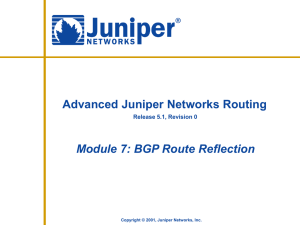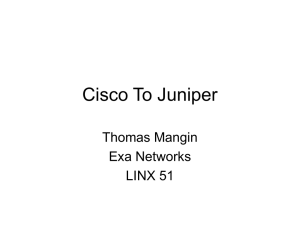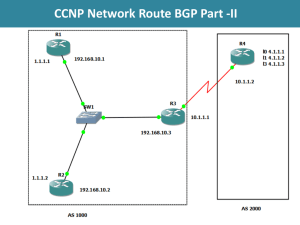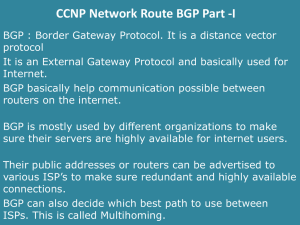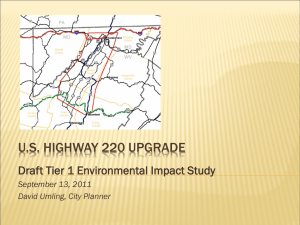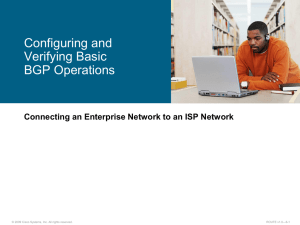Powerpoint - Workshops
advertisement
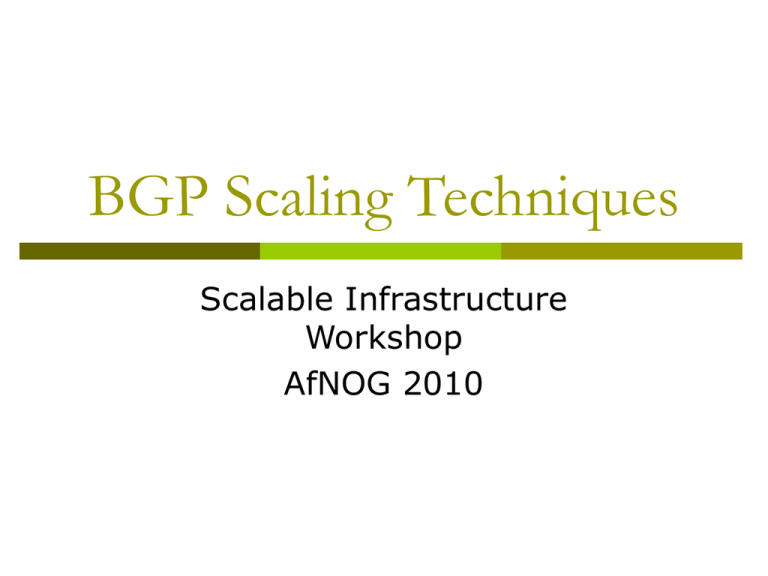
BGP Scaling Techniques Scalable Infrastructure Workshop AfNOG 2010 BGP Scaling Techniques How to scale iBGP mesh beyond a few peers? How to implement new policy without causing flaps and route churning? How to reduce the overhead on the routers? BGP Scaling Techniques Original BGP specification and implementation was fine for the Internet of the early 1990s But didn’t scale Issues as the Internet grew included: Scaling the iBGP mesh beyond a few peers? Implement new policy without causing flaps and route churning? Keep the network stable, scalable, as well as simple? BGP Scaling Techniques Current Best Practice Scaling Techniques Route Refresh Peer-groups Route Reflectors (and Confederations) Deprecated Scaling Techniques Soft Reconfiguration Route Flap Damping Dynamic Reconfiguration Non-destructive policy changes Route Refresh Problem: Hard BGP peer reset required after every policy change because the router does not store prefixes that are rejected by policy Hard BGP peer reset: Tears down BGP peering Consumes CPU Severely disrupts connectivity for all networks Solution: Route Refresh Route Refresh Capability Facilitates non-disruptive policy changes No configuration is needed Automatically negotiated at peer establishment No additional memory is used Requires peering routers to support “route refresh capability” – RFC2918 clear ip bgp x.x.x.x [soft] in tells peer to resend full BGP announcement clear ip bgp x.x.x.x [soft] out resends full BGP announcement to peer Dynamic Reconfiguration Use Route Refresh capability if supported Supported on virtually all routers Find out from “show ip bgp neighbor” Non-disruptive, “Good For the Internet” Otherwise use Soft Reconfiguration IOS feature Only hard-reset a BGP peering as a last resort Consider the impact of a hard-reset of BGP to be equivalent to a router reboot Soft Reconfiguration Now deprecated — but: Router normally stores prefixes which have been received from peer after policy application Enabling soft-reconfiguration means router also stores prefixes/attributes received prior to any policy application Uses more memory to keep prefixes whose attributes have been changed or have not been accepted Only useful now when operator requires to know which prefixes have been sent to a router prior to the application of any inbound policy Configuring Soft reconfiguration router bgp 100 neighbor 1.1.1.1 remote-as 101 neighbor 1.1.1.1 route-map infilter in neighbor 1.1.1.1 soft-reconfiguration inbound ! Outbound does not need to be configured ! Then when we change the policy, we issue an exec command clear ip bgp 1.1.1.1 soft [in | out] Notes: When “soft reconfiguration” is enabled, there is no access to the route refresh capability clear ip bgp 1.1.1.1 [in | out] will also do a soft refresh Soft Reconfiguration discarded peer normal soft BGP in table BGP in process sh ip bgp neigh … route BGP table sh ip bgp neigh … received peer sh ip bgp neigh … advertised accepted BGP out process sh ip bgp Managing Policy Changes clear ip bgp <addr> [soft] [in|out] <addr> may be any of the following: x.x.x.x * ASN external peer-group <name> IP address of a peer all peers all peers in an AS all external peers all peers in a peer-group Peer Groups Saving Time! Peer Groups Without peer groups iBGP neighbours receive same update Large iBGP mesh slow to build Router CPU wasted on repeat calculations Solution – peer groups! Group peers with same outbound policy Updates are generated once per group Peer Groups – Advantages Makes configuration easier Makes configuration less prone to error Makes configuration more readable Lower router CPU load iBGP mesh builds more quickly Members can have different inbound policy Can be used for eBGP neighbours too! Configuring Peer Group router bgp 100 neighbor ibgp-peer peer-group neighbor ibgp-peer remote-as 100 neighbor ibgp-peer update-source loopback 0 neighbor ibgp-peer send-community neighbor ibgp-peer route-map outfilter out neighbor 1.1.1.1 peer-group ibgp-peer neighbor 2.2.2.2 peer-group ibgp-peer neighbor 2.2.2.2 route-map infilter in neighbor 3.3.3.3 peer-group ibgp-peer Note how 2.2.2.2 has different inbound filter from the peer-group Configuring Peer Group router bgp 100 neighbor external-peer peer-group neighbor external-peer send-community neighbor external-peer route-map set-metric out neighbor 160.89.1.2 remote-as 200 neighbor 160.89.1.2 peer-group external-peer neighbor 160.89.1.4 remote-as 300 neighbor 160.89.1.4 peer-group external-peer neighbor 160.89.1.6 remote-as 400 neighbor 160.89.1.6 peer-group external-peer neighbor 160.89.1.6 filter-list infilter in Peer Groups Always configure peer-groups for iBGP Consider using peer-groups for eBGP Even if there are only a few iBGP peers Easier to scale network in the future Especially useful for multiple BGP customers using same AS (RFC2270) Also useful at Exchange Points where ISP policy is generally the same to each peer Peer-groups are essentially obsoleted But are still widely considered best practice Replaced by update-groups (internal IOS coding – not configurable) Enhanced by peer-templates (allowing more complex constructs) Route Reflectors Bigger networks! Scaling iBGP mesh Avoid n(n-1)/2 iBGP mesh n=1000 nearly half a million ibgp sessions! 13 Routers 78 iBGP Sessions! Two solutions Route reflector – simpler to deploy and run Confederation – more complex, corner case benefits Route Reflector: Principle Route Reflector A AS 100 B C Route Reflector Reflector receives path from clients and nonclients Selects best path If best path is from client, reflect to other clients and non-clients If best path is from non-client, reflect to clients only Non-meshed clients Described in RFC4456 Clients Reflectors A B C AS 100 Route Reflector Topology Divide the backbone into multiple clusters At least one route reflector and few clients per cluster Route reflectors are fully meshed Clients in a cluster could be fully meshed Single IGP to carry next hop and local routes Route Reflectors: Loop Avoidance Originator_ID attribute Carries the RID of the originator of the route in the local AS (created by the RR) Cluster_list attribute The local cluster-id is added when the update is sent by the RR Cluster-id is router-id (address of loopback) Do NOT use bgp cluster-id x.x.x.x Route Reflectors: Redundancy Multiple RRs can be configured in the same cluster – not advised! All RRs are in the cluster must have the same cluster ID (otherwise it is a different cluster) A router may be a client of RRs in different clusters Common today in ISP networks to overlay clusters – redundancy achieved that way Each client has two RRs = redundancy Route Reflectors: Benefits Solves iBGP mesh problem Packet forwarding is not affected Normal BGP speakers co-exist Multiple reflectors for redundancy Easy migration Multiple levels of route reflectors Route Reflectors: Migration Where to place the route reflectors? Follow the physical topology! This will guarantee that the packet forwarding won’t be affected Configure one RR at a time Eliminate redundant iBGP sessions Place one RR per cluster Route Reflector: Migration AS 300 A B AS 100 E AS 200 C D F G Migrate small parts of the network, one part at a time. Configuring a Route Reflector router bgp 100 neighbor 1.1.1.1 neighbor 1.1.1.1 neighbor 2.2.2.2 neighbor 2.2.2.2 neighbor 3.3.3.3 neighbor 3.3.3.3 remote-as 100 route-reflector-client remote-as 100 route-reflector-client remote-as 100 route-reflector-client BGP Scaling Techniques These 3 techniques should be core requirements on all ISP networks Route Refresh (or Soft Reconfiguration) Peer groups Route reflectors Route Flap Damping Network Stability for the 1990s Network Instability for the 21st Century! Route Flap Damping For many years, Route Flap Damping was a strongly recommended practice Now it is strongly discouraged as it causes far greater network instability than it cures But first, the theory… Route Flap Damping Route flap Going up and down of path or change in attribute BGP WITHDRAW followed by UPDATE = 1 flap eBGP neighbour going down/up is NOT a flap Ripples through the entire Internet Wastes CPU Damping aimed to reduce scope of route flap propagation Route Flap Damping (Continued) Requirements Fast convergence for normal route changes History predicts future behaviour Suppress oscillating routes Advertise stable routes Implementation described in RFC2439 Operation Add penalty (1000) for each flap Exponentially decay penalty Half life determines decay rate Penalty above suppress-limit Change in attribute gets penalty of 500 Do not advertise route to BGP peers Penalty decayed below reuse-limit Re-advertise route to BGP peers Penalty reset to zero when it is half of reuselimit Operation 4000 Suppress limit 3000 Penalty 2000 Reuse limit 1000 0 0 1 2 3 4 5 6 7 8 9 10 11 12 13 14 15 16 17 18 19 20 21 22 23 24 25 Time Network Announced Network Not Announced Network Re-announced Operation Only applied to inbound announcements from eBGP peers Alternate paths still usable Controlled by: Half-life (default 15 minutes) reuse-limit (default 750) suppress-limit (default 2000) maximum suppress time (default 60 minutes) Configuration Fixed damping router bgp 100 bgp dampening [<half-life> <reuse-value> <suppress-penalty> <maximum suppress time>] Selective and variable damping bgp dampening [route-map <name>] route-map <name> permit 10 match ip address prefix-list FLAP-LIST set dampening [<half-life> <reuse-value> <suppress-penalty> <maximum suppress time>] ip prefix-list FLAP-LIST permit 192.0.2.0/24 le 32 Route Flap Damping History First implementations on the Internet by 1995 Vendor defaults too severe RIPE Routing Working Group recommendations in ripe-178, ripe-210, and most recently ripe229 But many ISPs simply switched on the vendors’ default values without thinking Serious Problems: "Route Flap Damping Exacerbates Internet Routing Convergence“ “What is the sound of one route flapping?” Zhuoqing Morley Mao, Ramesh Govindan, George Varghese & Randy H. Katz, August 2002 Tim Griffin, June 2002 Various work on routing convergence by Craig Labovitz and Abha Ahuja a few years ago “Happy Packets” Closely related work by Randy Bush et al Problem 1: One path flaps: BGP speakers pick next best path, announce to all peers, flap counter incremented Those peers see change in best path, flap counter incremented After a few hops, peers see multiple changes simply caused by a single flap prefix is suppressed Problem 2: Different BGP implementations have different transit time for prefixes Some hold onto prefix for some time before advertising Others advertise immediately Race to the finish line causes appearance of flapping, caused by a simple announcement or path change prefix is suppressed Solution: Do NOT use Route Flap Damping whatever you do! RFD will unnecessarily impair access to your network and to the Internet More information contained in RIPE Routing Working Group recommendations: www.ripe.net/ripe/docs/ripe-378.[pdf,html,txt]

